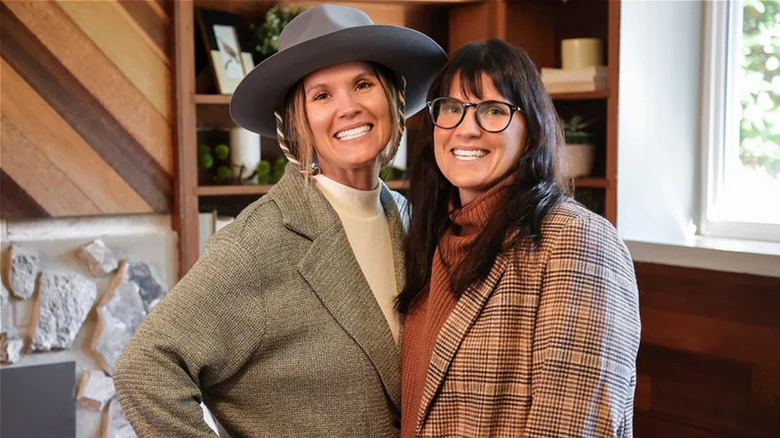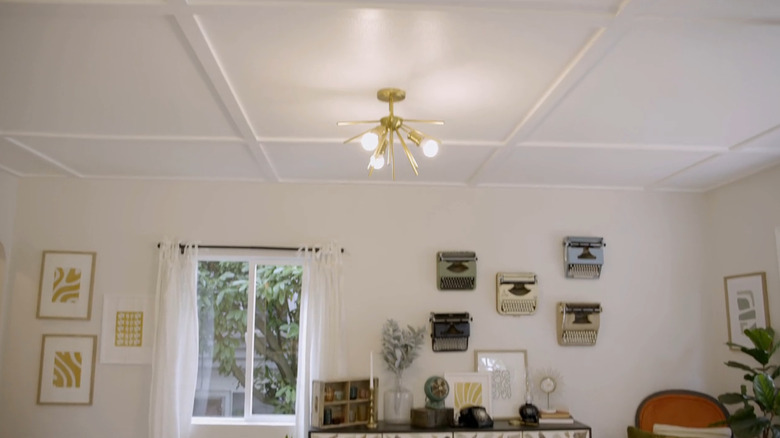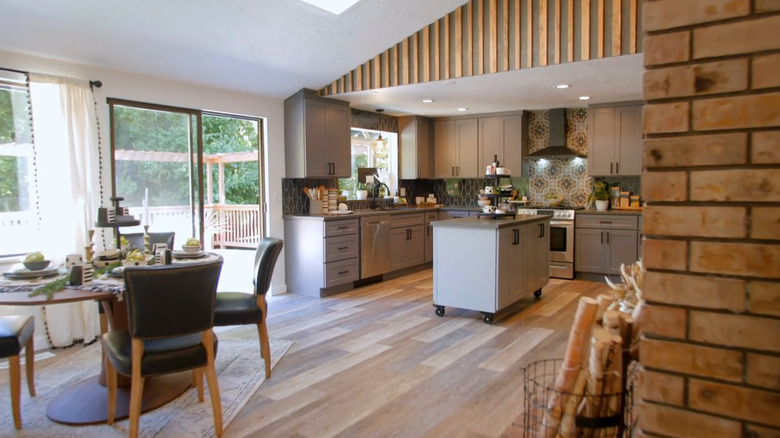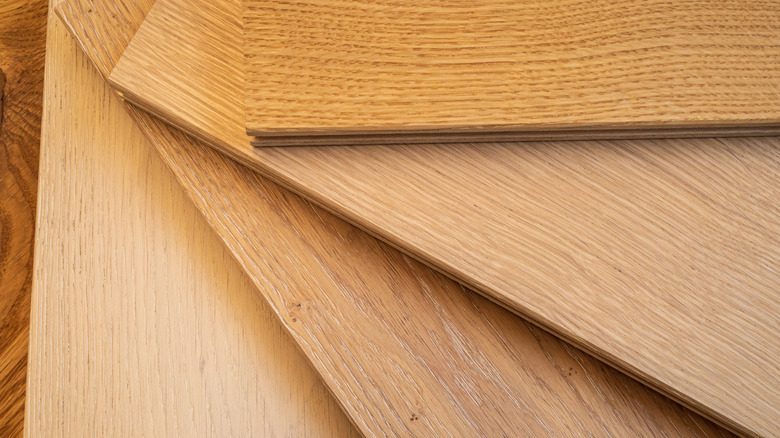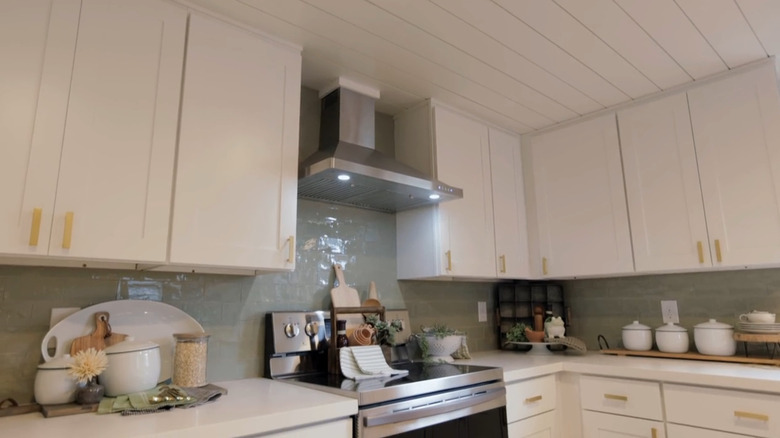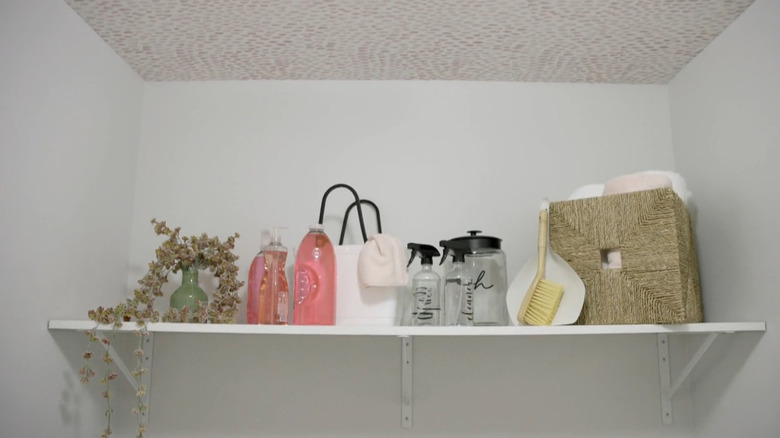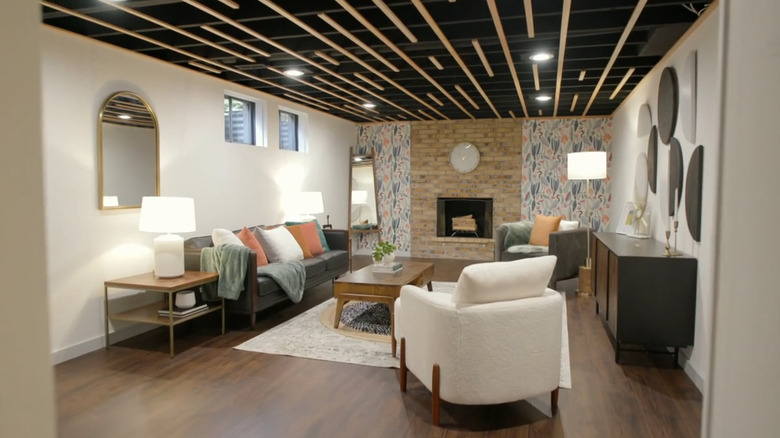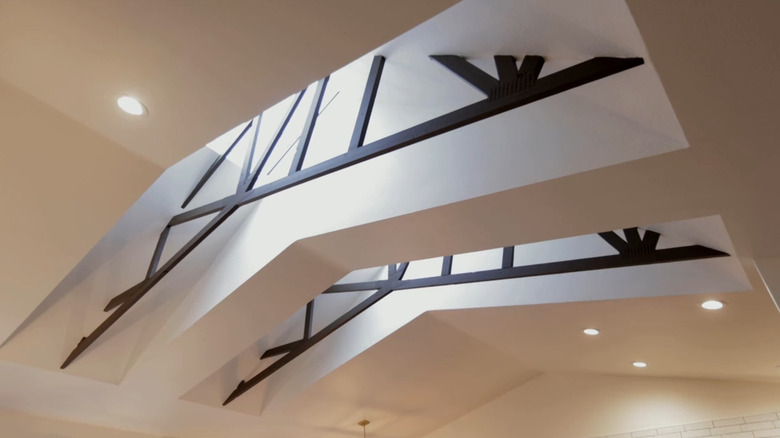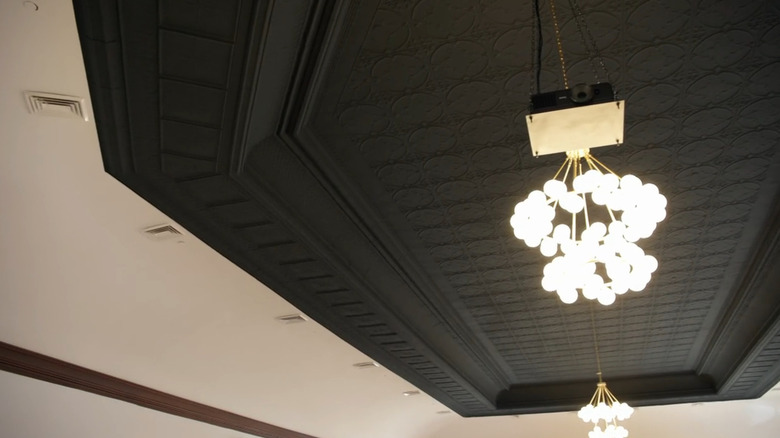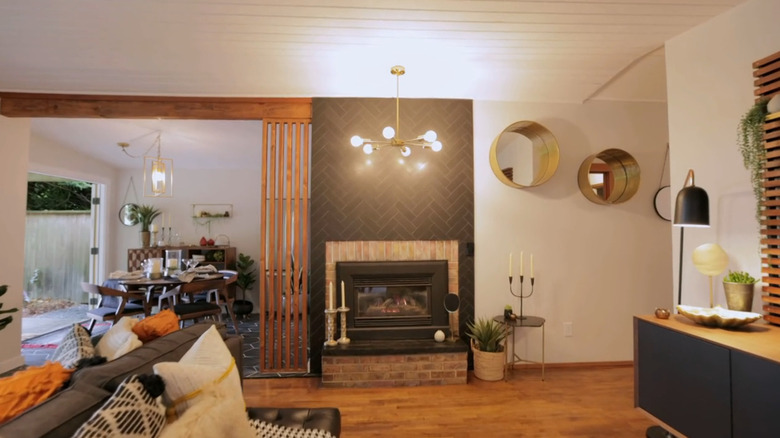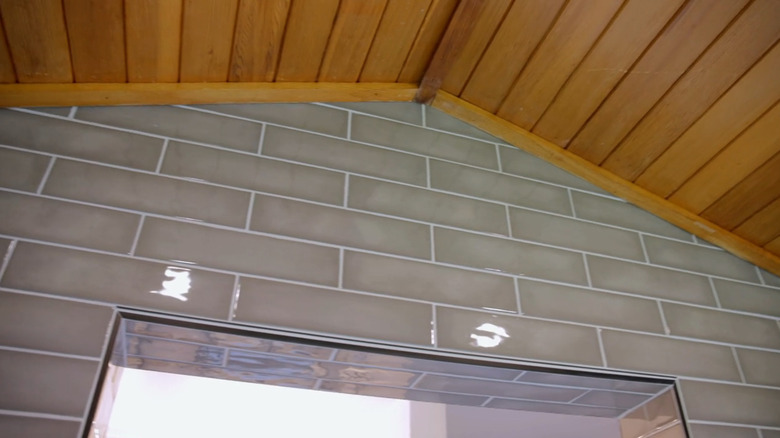Unique Ceiling Design Choices Inspired By The Stars Of Unsellable Houses
We may receive a commission on purchases made from links.
When it comes to designing a home, people put loads of thought into what to do with their walls. They pour over paint samples, consider wallpaper designs, and weigh if wainscoting would help add texture and interest to the room. But when it comes to the ceiling, most roll on white paint and call it a day. But overlooking this part of the room can be a big mistake. Applying those same finishes to the ceiling can make an eye-catching statement that not only makes it more aesthetic, but also increases your home value. No one knows this better than twin realtors Lyndsay Lamb and Leslie Davis, the stars of "Unsellable Houses." When a house sits forgotten on the market, one way they transform it into a hot listing is to add a feature to the ceiling. It's these small details that make the houses more memorable.
These stunning ceiling designs can run the gamut from simple to complex. For instance, in some homes, they add a bit of paint to completely transform the look, like when they painted copper ceiling tiles black to make it a focal point in the room. Other times, they're a little more architectural, like when they installed a board and batten ceiling in a living room to make the small space more interesting. Below are some of the best ceiling design choices from "Unsellable Houses" and how you can incorporate them into your own home.
Create a board and batten ceiling to add texture
When a room is falling flat in design, Lamb and Davis like to utilize board and batten to give it a boost. This feature uses thin pieces of wood called "batten" that are attached to panels, or "boards." They are attached either vertically or in a box design. This creates a sense of depth and makes the room feel more thought out. They utilized this architectural trick in Season 3, Episode 4 when they transformed a rental home's living room ceiling. They wanted to differentiate the living room from the adjoining dining room, helping create a clear divide between the two spaces. "I feel since this is kind of a smaller house, and this is our only living room space, if we can do a board and batten on the ceiling, I feel like that would really define the rooms," Davis explained in the episode.
If you want to utilize this same ceiling design to instantly elevate your home, you have a few options. The first is to hire a contractor to install it for you, though this will cost a pretty penny. Wall panelings on average cost $20 per square foot with labor, but that price can easily increase up to $40 per square foot if you want a more intricate design. Plus, the bigger your living room, the pricier this option will cost. If you have some home improvement skills, you can of course tackle this project yourself, but if you're an amateur and don't feel comfortable doing that, there is a second option. And that is to invest in a board and batten kit, such as the Ready Assemble Wall Molding Kit on Etsy. It costs $450+, which is much cheaper than hiring a professional, and you can share your specific measurements to get the exact size you need.
Transform a drop ceiling with wood
Drop ceilings are right up there with popcorn ceilings when it comes to outdated trends. These are secondary ceilings installed underneath the primary ones and are often used to hide plumbing, vents, or damage. While they serve a purpose, they're unpopular because they make a room feel squat and enclosed. However, Lamb and Davis have a clever way to upgrade a basic drop ceiling, and that is to panel the above wall with wood. This will only work if the drop ceiling is part of an open floor plan, but it's a great way to make the feature feel architectural rather than undesirable. In Season 3, Episode 3, they originally wanted to remove the drop ceiling to create more height, but there was a truss system inside that was supporting the roof. "Now we've got to come up with a way to distract from the drop ceiling and make it look like it's part of the design," Lamb explained in the episode. They did so by adding wooden slats that echoed the wooden beam on the ceiling and the brown brick texture in the fireplace, making the drop ceiling look intentional.
To recreate the same look in your own home, transform the triangular wall above the drop ceiling into a work of art. You can do so by painting it a color that echoes the kitchen cabinets underneath and adding something easy to install on top, like wooden slats. Other ideas could be using shiplap for a farmhouse look, board and batten for a heritage aesthetic, or artificial brick for a more industrial look. Just make sure it matches the style of your particular home.
Add wood flooring to the ceiling
It might seem odd, but hear the sisters out. Davis and Lamb used wood flooring in an unexpected way in Season 5 of "Rock the Block," adding engineered hardwood to the ceiling. Not only were the boards the perfect bleached wood color to pair with the coastal aesthetic of the house, but they also had added benefits for the team's budget and labor. "This unconventional design choice ... proved to be practical, more budget-friendly, and easier to install, prep, and maintain than traditional wood," Davis explained in an Instagram post. That's because engineered wood is lighter than natural wood, making it easier to lift and nail to the ceiling. You also don't need to sand, stain, or seal it to get your desired color, saving you time and money.
If you want to recreate this statement ceiling in your own home, you can use the same planks the realtors did in "Rock the Block." Davis and Lamb utilized "Laguna" White Oak Engineered Hardwood from Robbins Flooring. They are 7 1/2 inches wide, allowing you to cover a fair amount of ceiling space quickly. They're also low gloss and wire brushed, which makes them appear more like authentic hardwood. These particular planks can only be found in specialty stores, so if there are none near your location, you can also consider using planks from big box brands like Floor & Decor. For instance, its White Oak Engineered Hardwood is also 7 inches wide and can be ordered online.
Add shiplap to the ceiling
Shiplap isn't just for Joanna Gaines — Davis and Lamb also utilize it from time to time to bring some texture to a room. Fans saw this in action in Season 2, Episode 9, when the realtors flipped a historic home. "It's hard to resist a good shiplap surface. It provides texture and interest in a space without getting too loud," Lamb explained on her blog, Lamb & Co. "In this house, we decided the kitchen needed a little extra splash of homey-ness, so we decided to add shiplap to the ceiling. It fit well with the classic white cabinets and really added definition to the space." Originally, the kitchen had a drop tile ceiling and fluorescent lights, making it seem like something in an office and not a home. Lamb explained they decided on shiplap specifically to "tie in that older style but give it something unique." It was the perfect choice.
To recreate this look in your own home, you can either hire a contractor to do it or attempt to tackle the project yourself. If you would like to outsource the project, installing it often costs between $3 to $11 per square foot, which includes labor and material costs. However, if you want to do it yourself, please note that this is best suited for someone who has home improvement experience. That's because you will have to nail the planks to ceiling joists, account for unstraight ceilings, which will throw off your plank placement, and cut out holes for recessed lights, ceiling vents, or light fixtures.
Wallpaper the fifth wall
Wallpaper isn't just for walls — it's also a great way to add some interest to a ceiling! In Season 3, Episode 8, Lamb and Davis added personality to a small house by integrating lots of color. Not only did the kitchen feature blush pink subway tiles and forest green cabinetry, but Lamb wanted to make a statement in the adjoining laundry room by adding pink, spotted wallpaper to the ceiling. At first Davis was unconvinced, but Lamb explained it was to create a memorable moment in the listing. "The laundry room's right off the kitchen, and it is also the entry off of the garage. So, realistically, whoever buys this home is going to park in the garage and come in through that room every single day. Why not make it a really fun entry?" Lamb explained in the episode. In the end, Davis admitted that this added value since it wasn't a project most homeowners would take on themselves. "Now that I'm seeing it all come together, I think that it's something that buyers will pay extra for," she said. "I mean, this is a designer's touch."
To do this in your own home, it's much easier to wallpaper a smaller ceiling than a larger one. Consider trying this project in a laundry room, mudroom, powder room, entryway, or hallway. To make it cost-effective and DIY friendly, also consider using peel-and-stick wallpaper over traditional wallpaper that requires glue. This already has adhesive on it, and is relatively easy to remove if you change your mind or want to try a different pattern. You can find such wallpaper everywhere from big box stores like Target to specialty online stores like Spoonflower.
Add wooden accents to exposed ceilings
If you're looking for a more modern or graphic look, consider painting your ceiling black and adding wooden accents. This is exactly what the realtors did in Season 4, Episode 1 to create an "Organic Modern" design in a 1960s house. They did this in the bonus room in the house, which was the downstairs living room. It originally had ceiling tiles, but those were removed to reveal the joists of the basement ceiling. Lamb and Davis decided to leave the exposed ceiling and paint the wood black to give it an industrial vibe, but added wooden slats to tie in the organic theme of the house. Specifically, they used Sherwin Williams' Tricorn Black paint, which also appeared on the exterior trim of the house and interior doors, creating cohesion.
You can recreate the same look in a room with an exposed ceiling, whether that's in a basement, enclosed porch, or lofty living room. To make it appear less unfinished, you can paint the wood a dark, dramatic color, whether that's black, navy, or something trendier like forest green. This will make it appear more designed and less like an unfinished construction project. To create the wooden slats, you can buy a 7-pack bundle of 4-inch wide slats for $38 at Home Depot, and then stain them to your preferred shade. Or, if you want something more budget-conscious, you can also try staining 12-inch paint sticks, which cost $10 for 50 on Amazon.
Add trusses to add more character
To give your space a more country or provincial aesthetic, consider adding trusses to vaulted ceilings. That's what Lamb and Davis did in Season 2, Episode 7 to give their flipped house a transitional vibe, which mixes historic and modern elements together. One of the things the realtors loved in the listing was that it had skylights in the living room, creating a light and airy space. However, the skylights were cut in half by trusses covered in drywall that were helping to support the ceiling. "To minimize the impact of those drywall dividers and add some unique beauty to the room, we had Jeff remove all the drywall from around the supporting frames and simply leave the trusses exposed," Lamb explained in her blog. However, it took more than simply peeling back drywall. Jeff shared on her blog: "The trusses weren't originally built to be seen, so making them look finished and aesthetically pleasing by painting and filling in sheetrock around the openings was time-consuming, but it definitely paid off!"
If you have a vaulted ceiling, you can create something similar. If you don't have them installed, you can hire a contractor to create artificial trusses for you as an architectural feature. Since this requires getting high up on a vaulted ceiling and anchoring heavy wood to a ceiling, this is a project better left for the professionals who own scaffolds. Materials, on average, cost between $60 to $500 per truss, and the price is dependent on what kind of wood you use and how elaborate the design is. For labor costs, expect to pay between $25 and $75 per hour. Reach out to your local contractor for exact quotes.
Paint ceiling tiles to make them pop
Sometimes you don't have the budget to remove ceiling tiles and put in drywall. In those cases, you can update the tiles by adding a fresh coat of paint, transforming them from outdated to intentionally designed. That's exactly what the realtors did in Season 4, Episode 6, when they were tasked with renovating a ballroom. Specifically, they tackled the Feather Ballroom, which is a historic event space often rented out for weddings. The vision was to style the space in a "modern vintage" aesthetic. The ceiling utilized pressed copper tiles to create a heritage look, but the dingy white color felt old rather than historic. To make it feel updated, they painted it a deep black color. This not only made it more of a feature in the room, but it also helped the floral design pop. "That ceiling transformed the entire room," Davis said in the episode.
You can do something similar if you have outdated tiles on your ceiling. Simply paint them a contrasting color to make it seem like they were intentionally added to the space. If your are beyond the help of paint, then you can cover them with white styrofoam ceiling tiles. These are stamped with patterns that mimic the look of copper tiles, and they're a more affordable option than drywall. For example, a set of eight tiles costs $23 on Amazon. Plus, you can paint them a bold color to make a statement.
Paint wooden ceilings white to make the room brighter
Some people think it's a sin to paint any original millwork in a home, but if the paneling is making the room dark and dingy, then it could benefit from a coat of paint. That's exactly what Lamb and Davis thought in Season 2, Episode 4, when they tackled a mid-century home. The architecture typically utilizes a lot of wooden features, but it can sometimes make a home appear den-like rather than cozy. That was the case in the home's living room, which had wooden floors, a wooden ceiling, a red brick fireplace, and red and orange walls. The textured ceiling made the living room appear squatter, like it was unusually low. "We wanted to brighten it up, so we painted the ceilings," Lamb explained in the episode. The end result looked similar to shiplap, making the space appear airier.
If you have wooden ceilings that are making your house feel drab, consider painting them. To do so, you'll need more products than just paint. If your wood has lots of knots and texture, it would be best to fill them so you don't see holes in the finished result. You can use something like Minwax Wood Putty, but you'll need to sand it smooth once dry. Then, since there is a risk of varnish bleeding through from under the paint, you'll need to lock it in with primer. Choose one that is specially formulated for glossy surfaces, like Zinsser Bulls Eye 1-2-3.
Add a cedar ceiling to the shower
As biophilic interior design is taking off, more and more people are looking for ways to add earthy accents to their spaces. If you're one of those people, you will want to take notes on what the realtors did in Season 3, Episode 12. As they transformed a primary bathroom from a dated '80s space to a modern organic spa, they decided to do something unexpected. As Lamb and Davis transformed the tub nook into a huge double shower, they decided to keep the wooden planks on the ceiling and stain them a more modern color. This helped to cinch that organic look they were going for. And since the shower had a window, there was enough light to make the wooden ceiling appear airy rather than confining.
While this accent ceiling appeared in a bathroom, you can do it in any room of your house. To decide, see which room could use a boost in interest. Is there a space that is void of any architectural features, or seems to fall flat no matter how you decorate it? Then a statement wooden ceiling could help transform it. Alternatively, if you plan to DIY this project, select your room based on which is easiest to plank. That means zeroing in on a space with lower ceilings that don't have many obstacles on them, such as ceiling vents, recessed lights, or dormers.
